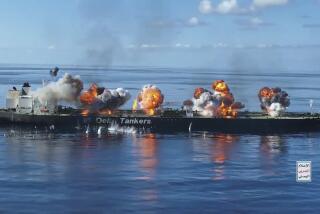Oil Drifts Toward Australia Coast : Spill: Some of the slick from a Greek tanker moves out to sea, but parts are within six miles of shore.
- Share via
PERTH, Australia — Light crude from Australia’s largest oil spill moved steadily toward 50 miles of pristine coastline Monday, but officials said much of the spill has moved out to sea or evaporated.
Oil from the disabled Greek tanker Kirki drifted into the Indian Ocean in thick patches of oily emulsion known as “mousse” and in thin surface streaks, said Mike Brown, a spokesman at a crisis center set up in nearby Jurien Bay.
For the record:
12:00 a.m. July 25, 1991 For the Record
Los Angeles Times Thursday July 25, 1991 Home Edition Part A Page 3 Column 1 Metro Desk 2 inches; 50 words Type of Material: Correction
Tanker spill--In an article in Tuesday’s editions about an oil spill off Australia, the Exxon Valdez accident of 1989 was incorrectly cited as the world’s worst tanker spill. The largest tanker spill in history involved the vessels Atlantic Empress and Aegean Captain, which collided off Trinidad and Tobago in 1979, spilling more than 88 million gallons.
Parts of the slick were six miles off the west coast by early today.
The estimated 2.9-million-gallon spill is about one-fourth the size of the slick produced by the Exxon Valdez accident in Alaska’s narrow Prince William Sound in 1989, the world’s worst tanker spill. Unlike Alaska, however, the Kirki’s Arabian light crude was breaking up and evaporating quickly in 16-foot swells on the open ocean, officials said.
“The ocean is breaking it up quite well,” said a government maritime spokeswoman. “It’s not a thick bloody mass anymore. It’s just a question of how much is left when it hits shore.”
So far, unseasonable offshore winds and an unusually strong coastal current have helped push most of the oil away from rich fishing grounds and wildlife areas.
Officials had expressed concern about the area’s $400-million-a-year rock lobster industry, a national park famed for its sand dunes and giant colonies of nesting birds and sea lions. Hundreds of humpback whales also migrate down the coast each year.
“Normally, we have strong onshore winds now,” Brown said. “Somebody’s prayers were answered.”
Chartered fishing boats towed wooden “breaker boards” to break up the mousse and hasten evaporation while crop-duster aircraft sprayed dispersal agents on oil still trickling from the stricken ship, Brown said.
Two tugs towed the Kirki stern-first, trying to take the tanker 100 miles offshore and several hundred miles north. Salvage experts aboard the ship hope to unload at least 60,000 tons of oil still sealed in 12 tanks behind the severed bow.
Officials plan to question Capt. Eleftherios Efstathopoulos today about reports from the crew that the ship’s starboard bow had cracked 17 days ago in the Persian Gulf. The crew said the bow began filling with water seven hours before the captain radioed for help at 3:38 a.m. Sunday.
“There is some evidence the captain changed course, but he did not report the problem and did not send a Mayday until the last moment,” said Richard Purkiss, head of the state’s oil pollution combat committee. “We’re very concerned he came so close to Australia’s coast.”
Efstathopoulos, 41, told local reporters that the ship was listing badly at 8 p.m. Saturday, and he discovered that empty ballast tanks had ruptured and filled with water. He said the bow began to separate from the weight of the water about 2:30 a.m. The friction-heated metal then sparked fierce fires as oil poured onto gale-driven seas.
“I said to my friends, ‘Now is the end,’ ” chief engineer Nick Bijarakis told the newspaper West Australian. “All the sea around the ship was on fire.”
With the bow gone, the captain said he thought his fully laden 97,000-ton tanker would break up and sink 20 miles offshore, the newspaper reported.
During the nightlong drama, some crew members tried to abandon ship but were unable to lower a lifeboat in the giant swells. All 37 crew members were later rescued by helicopters.
Hundreds of volunteers signed up with the Department of Conservation and Land Management to help clear beaches and clean birds and wildlife in case oil fouls the shore and coastal islands.
“The phone’s been ringing off the hook,” said a harried official. “Everyone wants to help.”
More to Read
Sign up for Essential California
The most important California stories and recommendations in your inbox every morning.
You may occasionally receive promotional content from the Los Angeles Times.













